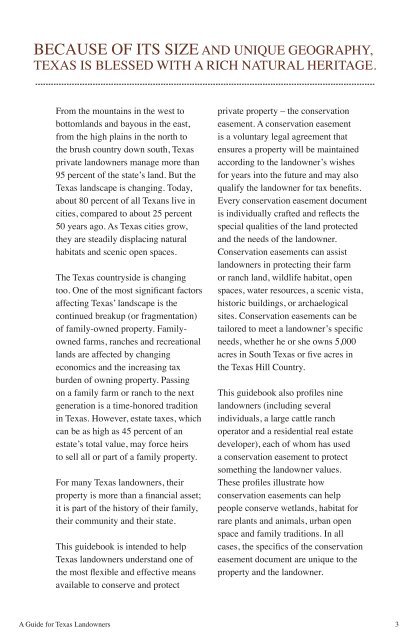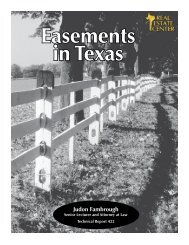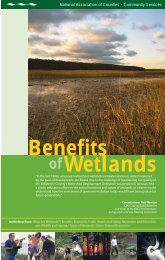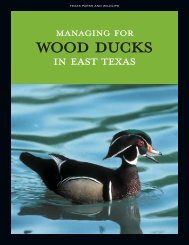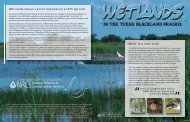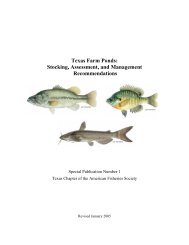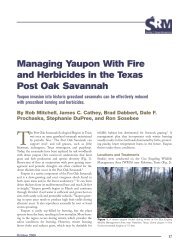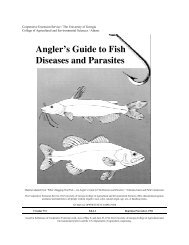Conservation Easements, A Guide for Texas Landowners
Conservation Easements, A Guide for Texas Landowners
Conservation Easements, A Guide for Texas Landowners
You also want an ePaper? Increase the reach of your titles
YUMPU automatically turns print PDFs into web optimized ePapers that Google loves.
Because of its size and unique geography,<br />
<strong>Texas</strong> is blessed with a rich natural heritage.<br />
From the mountains in the west to<br />
bottomlands and bayous in the east,<br />
from the high plains in the north to<br />
the brush country down south, <strong>Texas</strong><br />
private landowners manage more than<br />
95 percent of the state’s land. But the<br />
<strong>Texas</strong> landscape is changing. Today,<br />
about 80 percent of all Texans live in<br />
cities, compared to about 25 percent<br />
50 years ago. As <strong>Texas</strong> cities grow,<br />
they are steadily displacing natural<br />
habitats and scenic open spaces.<br />
The <strong>Texas</strong> countryside is changing<br />
too. One of the most significant factors<br />
affecting <strong>Texas</strong>’ landscape is the<br />
continued breakup (or fragmentation)<br />
of family-owned property. Familyowned<br />
farms, ranches and recreational<br />
lands are affected by changing<br />
economics and the increasing tax<br />
burden of owning property. Passing<br />
on a family farm or ranch to the next<br />
generation is a time-honored tradition<br />
in <strong>Texas</strong>. However, estate taxes, which<br />
can be as high as 45 percent of an<br />
estate’s total value, may <strong>for</strong>ce heirs<br />
to sell all or part of a family property.<br />
For many <strong>Texas</strong> landowners, their<br />
property is more than a financial asset;<br />
it is part of the history of their family,<br />
their community and their state.<br />
This guidebook is intended to help<br />
<strong>Texas</strong> landowners understand one of<br />
the most flexible and effective means<br />
available to conserve and protect<br />
private property – the conservation<br />
easement. A conservation easement<br />
is a voluntary legal agreement that<br />
ensures a property will be maintained<br />
according to the landowner’s wishes<br />
<strong>for</strong> years into the future and may also<br />
qualify the landowner <strong>for</strong> tax benefits.<br />
Every conservation easement document<br />
is individually crafted and reflects the<br />
special qualities of the land protected<br />
and the needs of the landowner.<br />
<strong>Conservation</strong> easements can assist<br />
landowners in protecting their farm<br />
or ranch land, wildlife habitat, open<br />
spaces, water resources, a scenic vista,<br />
historic buildings, or archaelogical<br />
sites. <strong>Conservation</strong> easements can be<br />
tailored to meet a landowner’s specific<br />
needs, whether he or she owns 5,000<br />
acres in South <strong>Texas</strong> or five acres in<br />
the <strong>Texas</strong> Hill Country.<br />
This guidebook also profiles nine<br />
landowners (including several<br />
individuals, a large cattle ranch<br />
operator and a residential real estate<br />
developer), each of whom has used<br />
a conservation easement to protect<br />
something the landowner values.<br />
These profiles illustrate how<br />
conservation easements can help<br />
people conserve wetlands, habitat <strong>for</strong><br />
rare plants and animals, urban open<br />
space and family traditions. In all<br />
cases, the specifics of the conservation<br />
easement document are unique to the<br />
property and the landowner.<br />
A <strong>Guide</strong> <strong>for</strong> <strong>Texas</strong> <strong>Landowners</strong><br />
3


